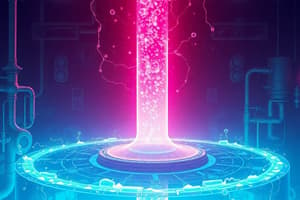Podcast
Questions and Answers
What is the primary function of a sparger in a stirred tank bioreactor?
What is the primary function of a sparger in a stirred tank bioreactor?
- To measure the liquid height in the tank
- To improve gas distribution throughout the vessel (correct)
- To heat the culture medium
- To add pressure to the liquid
If the height of liquid in a stirred tank bioreactor is twice the tank diameter, what is the recommended configuration of agitators?
If the height of liquid in a stirred tank bioreactor is twice the tank diameter, what is the recommended configuration of agitators?
- Three sets of agitators with varying sizes
- Multiple separate shafts for agitators
- Two sets of agitators mounted on the same shaft (correct)
- One set of agitators mounted at the bottom
What happens when the mass flow rate in a continuous stirred tank reactor does not equal the flow rate out?
What happens when the mass flow rate in a continuous stirred tank reactor does not equal the flow rate out?
- The stirring speed increases automatically
- The exit stream becomes denser
- The reactor reaches transient state (correct)
- The volume of the reactor decreases
How is the residence time in a CSTR calculated?
How is the residence time in a CSTR calculated?
What is a key characteristic of the exit stream of a CSTR?
What is a key characteristic of the exit stream of a CSTR?
What role do impellers play in a stirred tank bioreactor?
What role do impellers play in a stirred tank bioreactor?
When installing multiple sets of impellers in a stirred tank, what is the recommended separation distance?
When installing multiple sets of impellers in a stirred tank, what is the recommended separation distance?
In a stirred tank bioreactor, what is the consequence of having a non-uniform gas distribution?
In a stirred tank bioreactor, what is the consequence of having a non-uniform gas distribution?
What must be true about the composition of the feed in a continuous stirred tank reactor?
What must be true about the composition of the feed in a continuous stirred tank reactor?
Which of the following describes a steady state in a CSTR?
Which of the following describes a steady state in a CSTR?
Flashcards are hidden until you start studying
Study Notes
Stirred Tank Bioreactors (STRs)
- Air is introduced into the culture medium under pressure via a sparger, which can be a ring with holes or a tube with a single orifice.
- Spargers, in conjunction with impellers (agitators), facilitate effective gas distribution throughout the bioreactor.
- Impellers break down air bubbles into smaller sizes, ensuring uniform dispersion of gas in the medium, thus creating a homogeneous environment.
Agitator Specifications
- The number of agitators on the shaft correlates with the height of the liquid in the vessel.
- For optimal mixing, the liquid height should align with the designated height; mixing occurs efficiently with a single set of agitators.
- If liquid height exceeds two or three times the tank diameter (H = 2T or 3T), additional agitators are required on the same shaft.
- Impellers should be spaced at a distance of 4T apart to enhance mixing and mass transfer performance.
Continuous Stirred-Tank Reactor (CSTR) Characteristics
- CSTR operates at steady state, where the inlet flow rate must equal the outlet mass flow rate to prevent overflow or emptying.
- The feed has a uniform composition; the exit stream mirrors the concentration found within the tank.
- Reaction rates are dependent on the final output concentration.
- An impeller is installed to ensure efficient mixing within the reactor.
- The residence time is calculated by dividing the tank's volume by the average volumetric flow rate, representing how long a reagent spends in the tank.
Studying That Suits You
Use AI to generate personalized quizzes and flashcards to suit your learning preferences.




